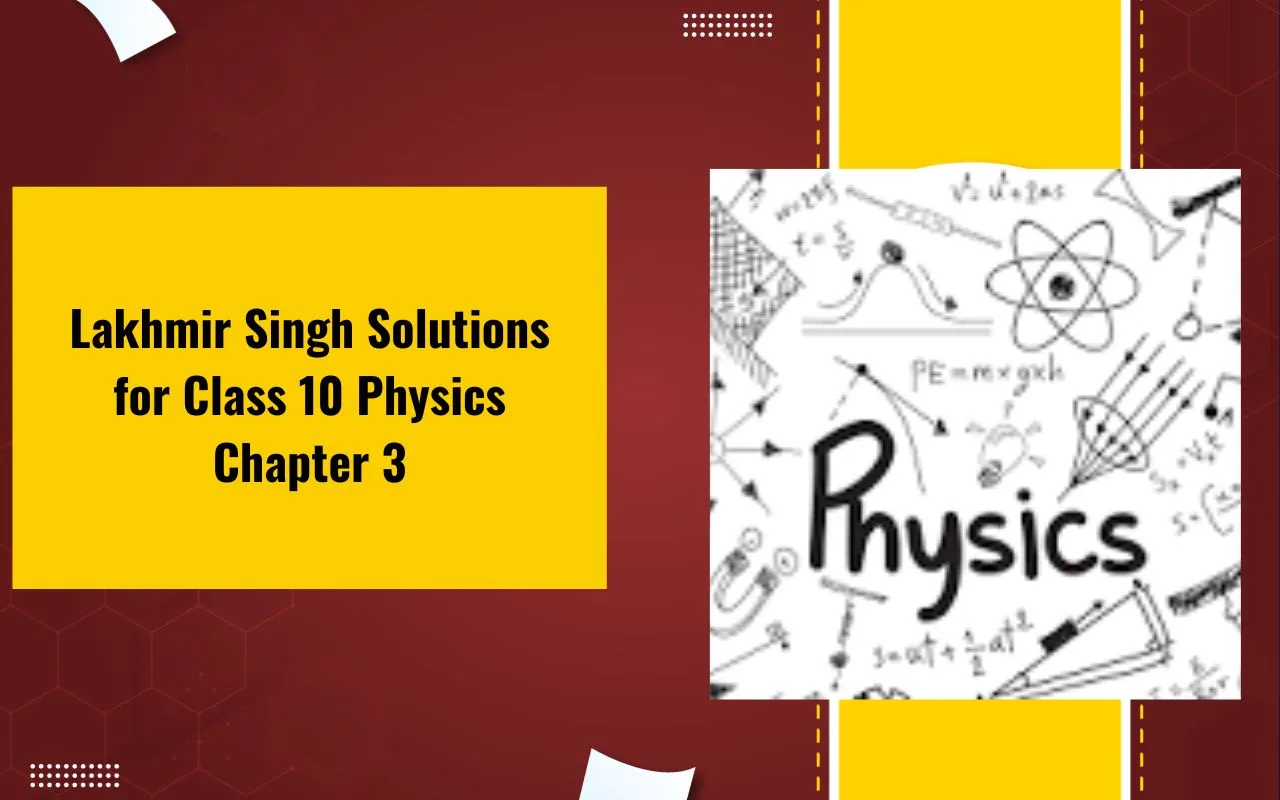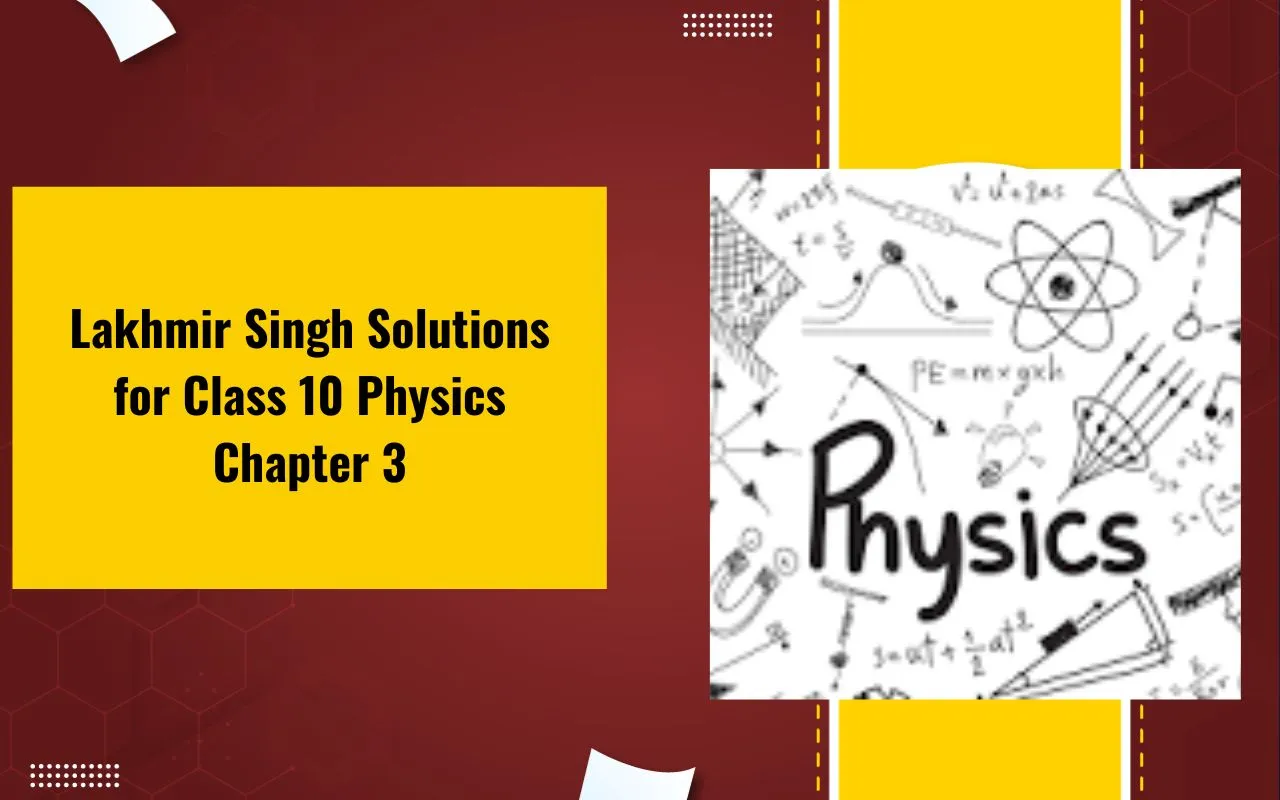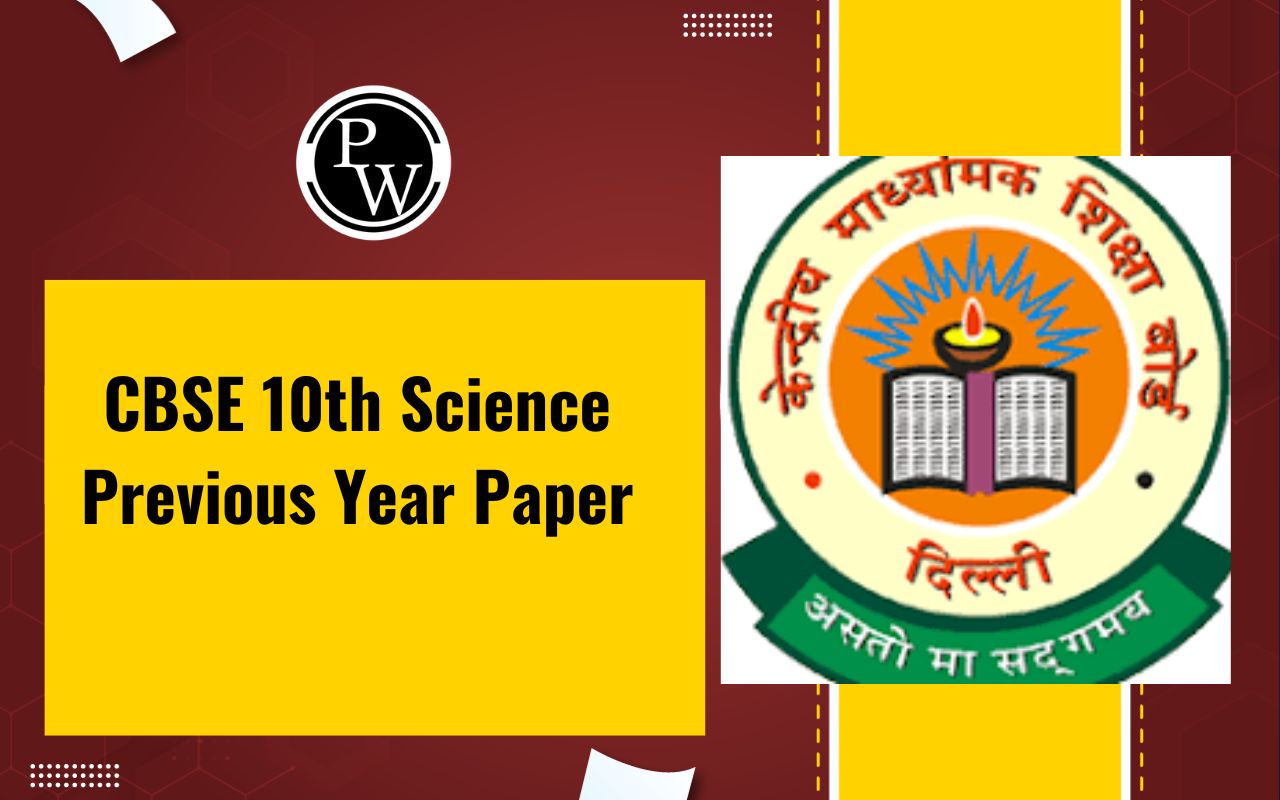

Lakhmir Singh Solutions for Class 10 Physics Chapter 3: Sources of energy play a crucial role in our daily lives, providing the power needed for various activities. Lakhmir Singh Solutions for Class 10 Physics Chapter 3, Sources of Energy, thoroughly explains different types of energy sources, their classifications, and their significance.
This chapter primarily focuses on renewable and non-renewable sources of energy, highlighting their advantages, disadvantages, and practical applications. It also discusses conventional energy sources like fossil fuels and hydroelectric power, along with non-conventional sources such as solar, wind, and nuclear energy. The solutions provide detailed explanations and step-by-step answers to textbook questions, making it easier for students to understand complex topics.
Lakhmir Singh Solutions for Class 10 Physics Chapter 3 Overview
Chapter 3 of Lakhmir Singh’s Class 10 Physics book, Sources of Energy, provides a detailed understanding of various energy sources and their utilization. It categorizes energy sources into renewable and non-renewable, highlighting their advantages, disadvantages, and environmental impacts. The chapter explains conventional sources like fossil fuels, thermal power, and hydroelectric power, along with non-conventional sources such as solar energy, wind energy, biomass, geothermal energy, and nuclear energy.
The chapter discusses key concepts like characteristics of good fuel, energy efficiency, and environmental consequences of using various energy sources. The Lakhmir Singh Solutions for this chapter provide clear explanations and step-by-step answers to textbook questions, helping students strengthen their knowledge and effectively prepare for their exams.
Lakhmir Singh Solutions for Class 10 Physics Chapter 3 PDF
The Lakhmir Singh Solutions for Class 10 Physics Chapter 3, Sources of Energy, provide comprehensive answers to all textbook questions with clear explanations. By referring to these solutions, students can enhance their conceptual knowledge and improve their exam preparation. The PDF link for Lakhmir Singh Solutions for Class 10 Physics Chapter 3 is available below for easy access and download.
Lakhmir Singh Solutions for Class 10 Physics Chapter 3 PDF
Lakhmir Singh Solutions for Class 10 Physics Chapter 3
The Lakhmir Singh Solutions for Class 10 Physics Chapter 3, Sources of Energy, provide well-structured answers to all the questions in the textbook. These solutions cover important topics like different sources of energy, conventional and non-conventional sources, fossil fuels, solar energy, wind energy, geothermal energy, and more. Each answer is explained in simple language to help students understand the concepts thoroughly and perform well in their exams. Here are the solutions for Lakhmir Singh Class 10 Physics Chapter 3.
Page No: 121
Very Short Answer Type Questions
Q1. Name a non-renewable source of energy other than fossil fuels.
Answer:
Nuclear fuels such as uranium is a non-renewable source of energy other than fossil fuels.
Q2. Define calorific value of a fuel.
Answer:
Calorific value of a fuel is defined as the amount of heat that is produced by burning completely 1 gram of fuel.
Q3. “The calorific value of cooking gas is 50kJ/g”. What does it mean?
Answer:
The calorific value of cooking gas is 50kJ/g means that if 1 gram of LPG is completely burnt then the amount of heat energy produced will be equal to 50kJ.
Q4. Which of the following produces more heat per unit mass on burning?
Coal or LPG
Answer:
Among coal and LPG, LPG will produce more heat per unit mass on burning because it has higher calorific value.
Q5. Define ignition temperature of a fuel.
Answer:
Ignition temperature of a fuel is defined as the minimum temperature that is required by the fuel in which it gets heated so that it can catch fire and start burning.
Q6. “The ignition temperature of a fuel is 80 degree Celsius”. What does this mean?
Answer:
The ignition temperature of a fuel is 80 degree Celsius means that the minimum temperature required by the fuel to catch fire before burning is 80 degree Celsius.
Q7. Fill in the blanks with a suitable word:
The amount of heat produced by burning a unit mass of a fuel completely is known as its ………. value.
Answer:
Calorific value.
Short Answer Type Questions
Q8. What is a source of energy? What are the two main categories of the sources of energy?
Answer:
A source of energy is defined as the source from which an adequate amount of energy can be obtained for a long period of time. Following are the two main categories of the sources of energy:
a) Renewable source of energy
b) Non-renewable source of energy
Q9. State any four characteristics of a good source of energy.
Answer:
A good source of energy will have following four characteristics:
a) Storage and transportation is easy.
b) The energy can be handled with ease and is safe.
c) The energy is easily available.
d) The amount of work done per unit mass is large.
Q10. What is meant by a non-renewable source of energy? Give two examples of non-renewable sources of energy.
Answer:
A non-renewable source of energy is defined as the source of energy which will exhaust very soon if used for a long period of time. These sources of energy are present in nature in limited amount. Examples of non-renewable sources of energy are coal and petroleum.
Q11. What is meant by a renewable source of energy? Give two examples of renewable sources of energy.
Answer:
A renewable source of energy is defined as the source of energy which is present in nature in large quantities and can be used for a very long period of time, they never exhaust. Examples of renewable source of energy are solar energy and wind energy.
Q12. What is the difference between a renewable and a non-renewable source of energy? Explain with examples.
Answer:
The difference between a renewable and a non-renewable source of energy is that renewable source of energy is available in abundant amount in nature whereas non-renewable source of energy is limited. The overuse of none-renewable source of energy will result in exhaustion of them.
Examples of renewable source of energy are solar and wind energy while examples of non-renewable source of energy are coal and petroleum.
Q13. Why are fossil fuels classified as non-renewable source of energy?
Answer:
Fossil fuels are classified as non-renewable source of energy because once it used it cannot be regained.
Q14. Name two sources of energy that you think are renewable. Give reason for your choice.
Answer:
Air and water are two sources of energy that are renewable because they are available in large quantities in nature and can be used repetitively.
Q15. Name two sources of energy which you consider to be non-renewable. Give reason for your choice.
Answer:
Petroleum and coal are the two sources of energy that are non-renewable. This is because once they are used completely, they cannot be regained.
Q16. a) Classify the following into renewable and non-renewable sources of energy:
Coal, wind, tides, petroleum, wood , natural gas
b) What is the basis of above classification?
Answer:
a) Renewable sources of energy: wind, tides, and wood
Non-renewable sources of energy: coal, petroleum, and natural gas.
b) The above classification of sources of energy is based on the inexhaustible and exhaustible characteristic of renewable and non-renewable sources of energy respectively.
Q17. Coal is said to be formed from the wood of trees. Why then is coal considered to be a non-renewable source of energy whereas wood is a renewable source of energy?
Answer:
Coal is considered to be a non-renewable source of energy while wood is considered to be a renewable source of energy because the accumulation of coal takes longer period than growing tress. Therefore, using coal at a very high rate will result in exhaustion of coal and therefore, it is considered to non-renewable source of energy.
Long Answer Type Questions
Q18. a) What is a fuel? Give five examples of fuels.
b) What are the characteristics of an ideal fuel or good fuel?
c) The calorific value and ignition temperature of fuel A are 55kJ/g and 80 degree Celsius respectively. These values for fuel B are 80kJ/g and 10 degree Celsius respectively. On burning, the fuel A produces CO2 and H2O while the fuel B produces CO2, CO, and SO2. Give three points of relative advantages and disadvantages of these two fuels.
Answer:
a) Fuel is defined as the substance that is burnt to produce heat energy. Wood, LPG, coal, kerosene, and diesel are the five examples of fuels.
b) Following are the characteristics of fuel:
i) The calorific value must be high.
ii) The ignition temperature of the fuel should be proper.
iii) The fuel should be readily available and inexpensive.
iv) When the fuel is burnt, there should not be release of harmful gases.
c) Fuel A:
i) The calorific value is low that is 55kJ/g which is a disadvantage
ii) The ignition temperature is 80 degree Celsius which moderate and is an advantage
iii) There are no harmful gases produced which is an advantage.
Fuel B:
i) The calorific value is high that is 80kJ/g which is an advantage
ii) The ignition temperature is 10 degree Celsius which is a disadvantage
iii) Harmful gases are released and that is the disadvantage
Multiple Choice Questions
Q19. An example of a renewable source of energy is:
a) petrol
b) natural gas
c) biogas
d) kerosene
Answer:
The correct answer is c) biogas
Q20. A non-renewable source of energy is:
a) wood
b) alcohol
c) hydrogen gas
d) natural gas
Answer:
The correct answer is d) natural gas
Q21. Which of the following is not a renewable source of energy?
a) wind
b) flowing water
c) fossil fuels
d) fuel wood
Answer:
The correct answer is c) fossil fuels
Q22. A good fuel is one which possesses:
a) high calorific value and low ignition temperature
b) high calorific value and high ignition temperature
c) high calorific value and moderate ignition temperature
d) low calorific value and moderate ignition temperature
Answer:
The correct answer is c) high calorific value and moderate ignition temperature
Q23. The fuel having a calorific value of 55kJ/g is likely to be:
a) biogas
b) methane gas
c) hydrogen gas
d) natural gas
Answer:
The correct answer is b) methane gas
Q24. A newly planted sapling usually grows and mature into a tree in more than:
a) 50 years
b) 25 years
c) 45 years
d) 15 years
Answer:
The correct answer is d) 15 years
Q25. Which of the following fuels has the highest calorific value?
a) natural gas
b) methane gas
c) hydrogen gas
d) biogas
Answer:
The correct answer is c) hydrogen gas
Q26. The fuel having the lowest calorific value is:
a) coal
b) wood
c) charcoal
d) kerosene
Answer:
The correct answer is b) wood
Q27. There are four fuels which all contain only carbon and hydrogen. The fuel having highest calorific value will be one which has:
a) more of carbon but less of hydrogen
b) less of carbon but more of hydrogen
c) equal proportions of carbon and hydrogen
d) less of carbon as well as less of hydrogen
Answer:
The correct answer is b) less of carbon but more of hydrogen
Q28. One of the following is not a characteristics of a good fuel. This is:
a) high calorific value
b) no emission of smoke
c) smooth burning
d) high ignition temperature
Answer:
The correct answer is d) high ignition temperature
Q29. Which of the following is not a fossil fuel?
a) coal
b) petroleum gas
c) biogas
d) natural gas
Answer:
The correct answer is c) biogas
Page No: 130
Very Short Answer Type Questions
Q1. Name the product of petroleum that is used to drive heavy vehicles.
Answer:
Diesel is the product of petroleum that is used to drive heavy vehicles.
Q2. Give one example of a good domestic fuel.
Answer:
LPG is an example of a good domestic fuel.
Q3. Name any one hydrocarbon fraction obtained during the fractional distillation of petroleum which is used as a domestic fuel.
Answer:
Kerosene is a hydrocarbon fraction that is obtained during the fractional distillation of petroleum which is used as a domestic fuel.
Q4. What are the various fuels which are used to generate electricity in a thermal power plant?
Answer:
Following are the various fuels that are used in the generation of electricity in a thermal power plant:
Coal, gas, and oil.
Q5. Name any four fractions obtained from petroleum which are used as fuels.
Answer:
Following are the fraction that are obtained from petroleum that are used as fuels:
Petroleum gas, diesel, kerosene, and petrol.
Q6. What is the composition of liquefied petroleum gas?
Answer:
The composition of liquefied petroleum gas is butane with smaller amounts of propane and ethane.
Q7. Which gaseous fuel is being used increasingly in transport vehicles like cars and buses these days?
Answer:
Compressed Natural Gas is used in transport vehicles such as cars and buses.
Q8. Write the full form of: a) LPG b) CNG
Answer:
a) LPG: Liquefied Petroleum Gas
b) CNG: Compressed Natural Gas
Q9. What is the main constituent of:
a) petroleum gas?
b) natural gas?
Answer:
a) The main constituent of petroleum gas is butane
b) The main constituent of natural gas is methane
Q10. Name the component which is found in natural gas as well as in biogas.
Answer:
The component which is found in natural gas as well as in biogas is butane.
Benefits of Solving Lakhmir Singh Solutions for Class 10 Physics Chapter 3
Conceptual Clarity: The solutions provide a detailed explanation of all concepts related to Sources of Energy, including renewable and non-renewable sources, their advantages, limitations, and practical applications. This helps build a solid conceptual foundation.
Effective Exam Preparation: By solving these solutions, students become familiar with the question patterns and difficulty levels commonly asked in board exams. This prepares them for writing accurate answers during exams.
Improved Problem-Solving Skills: Practicing these solutions helps enhance problem-solving abilities and analytical thinking, making it easier to tackle complex questions during exams.
Time Management: Regular practice of Lakhmir Singh Solutions helps students develop effective time management skills, essential for answering all questions within the allotted time during exams
Boosts Confidence: Comprehensive preparation with accurate solutions boosts students’ confidence and reduces exam-related stress.
Step-by-Step Explanations: The solutions follow a step-by-step approach, ensuring that students understand the method of answering questions effectively, which is especially helpful in numerical problems.
Lakhmir Singh Solutions for Class 10 Physics Chapter 3 FAQs
What is covered in Lakhmir Singh Solutions for Class 10 Physics Chapter 3?
Are Lakhmir Singh Solutions for Chapter 3 useful for board exams?
How can Lakhmir Singh Solutions help in scoring good marks in Physics?
Are the Lakhmir Singh Solutions for Chapter 3 enough for complete preparation?













